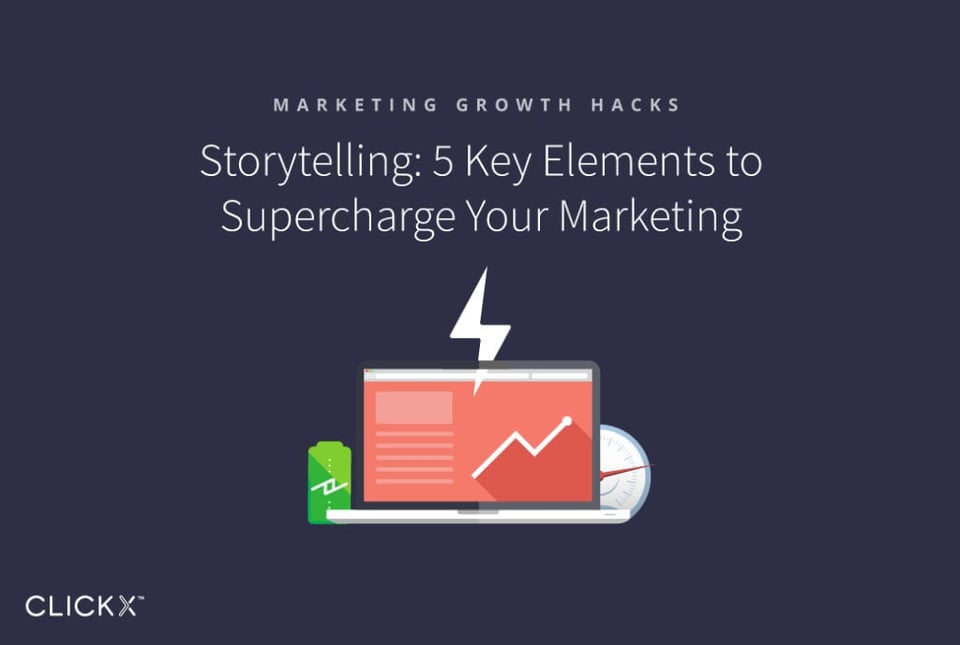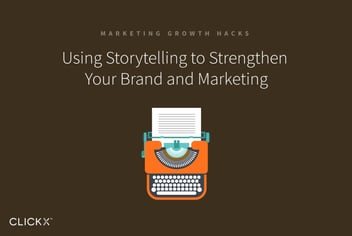Storytelling: 5 Key Elements to Supercharge Your Marketing
Here’s something I probably don’t need to remind you of: Small and medium business owners have it rough.
We don’t have the marketing budgets to compete with larger competitors financially. Unlike Wal-Mart or HP, we can’t plunk down the cash to buy a Super Bowl ad.
But we still desperately need to connect with our audience and win new customers to grow. Fortunately, there’s something we can do to earn invaluable attention no matter how limited our budget – something that resonates with people like nothing else.
We can become storytellers.

Why Storytelling Beats Blatant Sales Pitches Every Time
>Storytelling is woven deeply into our human psychology. Whenever we read or hear a compelling story, mirror neurons activate inside our brain as if we’re experiencing those sensations in real life.
Because storytelling doesn’t cost any money and is something everyone can learn, it will help you level the playing field with better-funded competitors. Storytelling is also a natural response to people’s increased skepticism (and downright mistrust) of blatant ads online.
People – including the ones you’d like to become customers – are busy. We have a zillion ways to distract ourselves with texting, social media, and other online diversions. Quite frankly, we don’t have time to pay attention to a blatant sales pitch.
But there’s something we always do have time for, whether it’s catching up on the latest gossip at the office or binge-watching Stranger Things. We make time for compelling stories.
If you can inject storytelling into your marketing efforts, you’ll bring in more customers and build better relationships. Here are five things you need to get started:
1. A Protagonist

Image credit: ErikaWittlieb
Every good story needs a hero. Without someone to root for, the audience gets bored and moves on. You’ve probably done this yourself after giving up on a book or TV show full of unlikable characters.
Who is the protagonist in your marketing story?
A lot of entrepreneurs simply assume it’s their company. After all, their company can solve the audience’s problem. Shouldn’t they be the hero in this situation?
Not exactly.
Positioning yourself as the protagonist is tempting. Especially after spending all that time and energy developing a great product or service. But if you approach your story as just an opportunity to brag about your offer and experience, your audience will get bored quickly.
Remember, your audience doesn’t know “who you are” as a business. At least not in the beginning. They’re looking for someone they can connect with – someone they can relate to instantly. Someone like themselves…
This is why great marketing stories feature the potential customer as the hero. What are their goals and dreams? What are their struggles? What must they overcome to improve their lives?
These are perfect topics for your stories to explore. You’ll immerse your audience right away because it’s easy for them to imagine themselves as the lead to the story. That makes them more receptive to hearing about your business solution!
[Tweet “Super charge your #marketing with storytelling: http://bit.ly/storytelling-supercharge-marketing”]
2. High Stakes

Image credit: Comfreak
Every great story needs drama. And we don’t get that drama unless we establish high stakes.
Imagine if you tried telling a story about your inability to decide which clothes to wear that morning. It’d take about three seconds before your audience zoned out and put their attention elsewhere. The stakes are simply too low. Who cares if you chose outfit A or outfit B?
When you think of great stories, on the other hand, the stakes are always high. There’s a lot to gain if the hero succeeds – and a ton to lose if they don’t. If Frodo didn’t doesn’t destroy the One Ring in Tolkien’s classic books, the world will plunge into darkness. If Walter White doesn’t make his drug operation pay off in Breaking Bad, he will die of cancer and leave his family penniless.
The stakes of people not doing business with you might not be world-ending, but they’re probably more serious than your audience might realize. It’s your job as a storyteller to paint a vivid picture of the consequences. Will there be wasted time, money, or opportunities? Poorer health? On the flip side, if someone does do business with you, what is there to gain?
We can’t afford to assume the audience understands the stakes, especially if you’re selling something completely new. Paint that picture for them – get them imagining just how different their lives could be if they did business with you – and you’ll connect with them emotionally.
3. A Compelling Hook

Image credit: MichaelGaida
Time is limited, and 24/7 access to smart phones and the internet is just giving us more and more potential distractions. Did you know the average person’s attention span is shorter than a goldfish’s?
Savvy marketers are aware of this. That’s why they start their stories with a bang. You need a hook to grab them and make them immediately intrigued.
Look for a dramatic moment to open your story right away. Your audience doesn’t have time to sift through all the build up and irrelevant back story. Where’s the conflict? The film The Martian starts out with Matt Damon already in trouble. After a powerful dust storm, he’s stranded on Mars… and completely alone. All the background info about the Mars mission and his character come out later.
One of the most useful ways to get better at this is to study other great openers. Next time you get sucked into an article or TV show, break down the opener. Ask yourself why it’s so effective. Then experiment by modeling it yourself.
Your opener doesn’t have to convince someone to buy your product. That’s far too much pressure. Its sole purpose? To intrigue the audience enough to hear what you have to say next.
4. Conflict

Image credit: Devanath
I already touched on the importance of high stakes. Your story won’t be compelling unless the protagonist has a lot to lose – or gain.
You also need a healthy dose of conflict. If Luke Skywalker just defeated Darth Vader without breaking a sweat, Star Wars wouldn’t be a Hollywood classic. Great stories require struggle. They become even more interesting when the odds are stacked against the protagonist, and when plenty of antagonizing forces stand in his or her way.
Because we want to make the potential customer the hero, now’s the time to hone in on the struggles they’re dealing with. Specifically, we want to talk about the struggles your business can help them solve.
This is a great place to start your marketing stories because it’s often the exact conversation already going on in the audience’s head. You can cut right to the heart of the conflict by incorporating it into your opener.
Who are the antagonists in your audience’s struggle? Is it self-doubt or a lack of resources? A jam-packed schedule or old age? The better you can pinpoint these forced (and describe them in vivid detail), the better you’ll connect with your audience.
5. A Satisfying Ending

Image credit: Witizia
Have you ever been captivated by a friend’s story… until they started spinning in circles without wrapping it up?
It’s one of the frustrating things an audience can face. Every good story must have a beginning, middle, and end. After introducing drama and stakes and someone the audience cares about, it’s the storyteller’s job to resolve that conflict.
A bad ending (or no ending) leaves a sour taste in the audience’s mouths. It can even make them overlook the fact that the rest of the story was good and move on to something else, disappointed.
The ending is key. That’s why I recommend knowing your ending before you create the rest of your marketing story. Knowing where you want to go will help you get there as quickly and compellingly as possible.
Ask yourself this: What is the next step I want my audience to take after reading this marketing message?
It might be to leave a comment on a blog post, join an email list, or buy a product. Every marketing story serves a different audience at different points along the buying journey.
The important thing is that you know where you’re going. That will help you lead your audience there seamlessly. After your story takes them on a journey, they can relive the tension by taking the next step in their business relationship with you.
[Tweet “Captivate your audience with storytelling. Here’s how to incorporate it into your #marketing strategy: http://bit.ly/storytelling-supercharge-marketing”]
Your Turn
Small and medium business owners don’t have the resources or brand recognition of multinational giants like Pepsi and Honda…
But they can tell great stories in their marketing.
In a time where it’s becoming increasingly difficult to buy someone’s attention through paid advertisements, compelling stories are a secret weapon to bring in new customers and connect with your audience.
Do you tell stories in your marketing messages? If so, what impact has it had on your audience? Leave a comment below and let us know!



